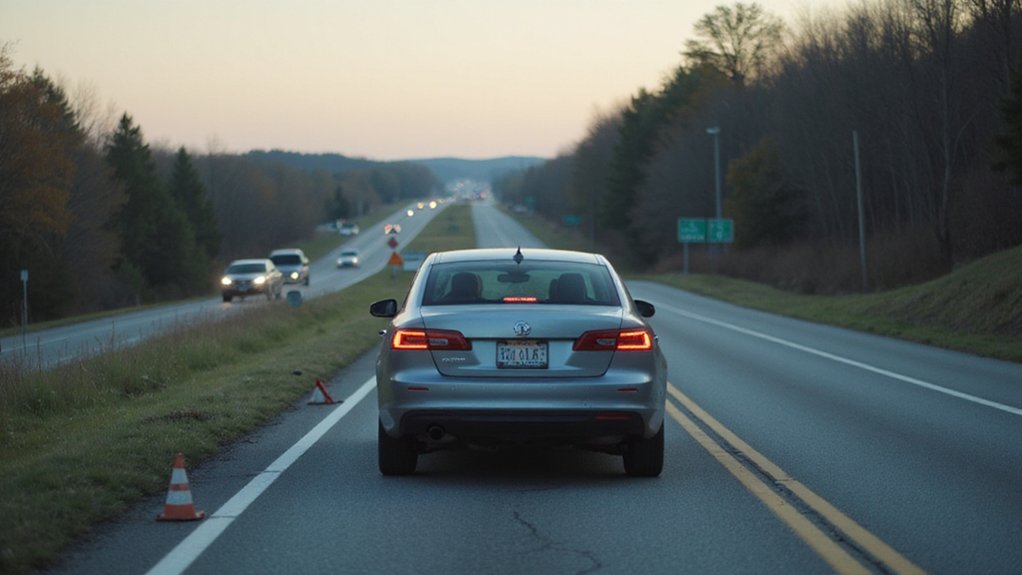When your car breaks down, you'll want to pull over to a safe, well-lit area with good visibility. Lock your doors, turn on hazard lights, and stay inside your vehicle. Call roadside assistance or 911 if needed, and keep communication open with the tow service. Be cautious of strangers offering help, and trust your instincts. Want to learn more about handling roadside emergencies like a pro?
Pull Over to a Safe Location
When your vehicle breaks down, finding a safe spot to pull over is crucial for your protection. Look for a wide shoulder, an exit ramp, or a parking lot away from heavy traffic. If possible, choose a well-lit area with good visibility. Roadside assistance services in Northeast Ohio can help you navigate these challenging situations safely, with professionals available 24/7 to support stranded drivers. Turn on your hazard lights to alert other drivers and signal that you're experiencing car trouble. Try to position your vehicle as far from moving traffic as you can, creating a buffer zone between you and passing cars. Stay inside your locked vehicle until help arrives.
Make Your Vehicle Highly Visible
Every stranded motorist needs to maximize their visibility to prevent potential accidents. Turn on your hazard lights immediately after pulling over, creating a clear warning signal to approaching vehicles.
If it's nighttime or you're on a dimly lit road, use your parking lights or interior lights to amplify visibility. Place reflective triangles or road flares behind your vehicle if you have them, creating a safety perimeter.
Wear a bright, reflective vest if available, which will help other drivers see you from a distance and reduce the risk of potential roadside incidents. Cleveland Tow Truck Pros offer 24/7 roadside assistance to help you quickly in emergency situations.
Stay Inside Your Locked Vehicle
Although roadside emergencies can feel stressful, staying inside your locked vehicle is one of the smartest safety strategies you can employ while waiting for a tow truck. Your locked car provides a protective barrier between you and potential roadside dangers.
Keep your doors locked, windows mostly up, and remain alert to your surroundings. If anyone approaches, you're safer inside with doors secured. Use this time to contact help, notify family, or stay calm. Your vehicle becomes a temporary sanctuary, protecting you until professional assistance arrives.
Alert Authorities and Roadside Assistance
Most drivers will encounter the need to quickly alert authorities and roadside assistance during a vehicle breakdown. Your safety depends on promptly notifying the right people about your situation.
Call 911 if you're in an unsafe location or experiencing a medical emergency. Contact your roadside assistance provider, whether through your insurance, auto club, or mobile app. Provide them with your exact location, vehicle description, and the nature of your problem. They'll dispatch help and give you estimated arrival times, helping you feel more secure and supported during this stressful moment.
Be Cautious of Strangers Offering Help
While waiting for a tow truck, you'll want to remain vigilant about strangers who might approach and offer unsolicited assistance. Not everyone has good intentions, so stay alert and protect yourself:
- Keep car doors locked and windows mostly closed
- Trust your instincts if someone seems suspicious or makes you uncomfortable
- Avoid sharing personal details or explaining your specific situation
- Stay inside your vehicle unless absolutely necessary for your wellbeing
If someone genuinely wants to help, they'll understand your caution and respect your limits. Your safety is the top priority.
Prepare Emergency Supplies
Since unexpected vehicle breakdowns can leave you stranded, it's crucial to have emergency supplies readily available in your car. Pack a safety kit with bottled water, non-perishable snacks, a first-aid kit, flashlight, and extra batteries.
Include warm blankets, jumper cables, a basic tool set, and a portable phone charger. Consider adding reflective warning triangles or road flares to increase visibility if you're stuck on the roadside. These supplies will help you stay comfortable and secure while waiting for professional assistance, giving you peace of mind during a stressful situation.
Keep Communication Open With Tow Service
When your vehicle breaks down, maintaining clear communication with your tow service becomes critical for ensuring a smooth and safe roadside rescue.
Stay connected and informed by:
- Exchanging precise contact details with the dispatcher
- Confirming your exact location using landmarks or GPS coordinates
- Requesting estimated arrival time and driver's identification
- Providing clear descriptions of your vehicle and current situation
Frequently Asked Questions
How Long Will It Take for the Tow Truck to Arrive?
You'll want to confirm the exact arrival time when calling for a tow. Most services estimate 30-90 minutes, depending on your location, traffic, and current service demand.
Is It Safe to Accept Water or Help From Nearby Drivers?
Don't accept water or help from strangers. You'll stay safest by remaining in your locked vehicle, calling 911 if you feel threatened, and waiting for the professional tow truck you've already contacted.
What if My Phone Battery Dies While Waiting for Assistance?
If your phone dies, stay calm. Ask a nearby business to charge it, use a car charger, or borrow a portable battery from another driver. Keep your safety as the top priority.
Can I Leave My Vehicle if I Feel Uncomfortable or Threatened?
If you feel unsafe, prioritize your personal safety. Don't hesitate to exit your vehicle, find a well-lit area, and call local authorities if you sense any immediate danger to yourself.
Should I Keep My Engine Running While Waiting for a Tow?
You shouldn't keep your engine running while waiting for a tow, as it wastes fuel, can lead to carbon monoxide buildup, and might cause unnecessary wear on your vehicle's systems.



